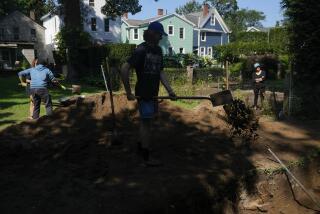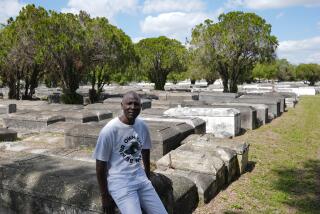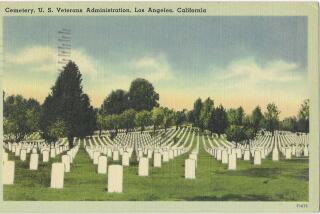New England Cemeteries Dying for Space
- Share via
BELMONT, Mass. — Oscar Barone has spent nearly all of his 92 years in this town outside Boston. He may have to spend eternity somewhere else.
Like a growing number of New England burial grounds, Belmont’s 140-year-old cemetery is full.
High land costs, rocky soil and neighborhoods that have had centuries to grow have left cemeteries with no room to expand and no place to go.
“I was born and bred here and I want to stay here,” said Barone, who hoped to be buried alongside his parents. “But people don’t think about the cemetery until they need it. That’s what happened in my case.”
The problem is as old as New England.
New England colonists made their cemeteries small in the 1600s and 1700s, and often buried people one on top of the other to fool neighboring Indians into believing fewer settlers had died.
Many cemeteries were laid out with the town and were quickly encircled by homes and businesses. When things got crowded, often the cemetery was excavated to make way for the living.
“A lot of cemeteries are running into this problem,” said Fred Laffond, superintendent of St. Joseph’s Cemetery in Keene, N.H., which will be full in 15 years. “What we have to do is, we have to be thinking about down the road 50 years.”
That means finding new land suitable for a cemetery, no easy task in the shallow, rocky soil that New England colonists found so inhospitable to farming.
“You just can’t put a cemetery anywhere,” Laffond said. “You have to have good drainage and no ledges.”
Moreover, property values are rebounding and generally higher than other parts of the country.
In Belmont, the cemetery has been closed to purchases of new burial plots for nine years.
The cemetery commission has been trying for three decades to find new space. It’s negotiating for land from a psychiatric hospital, which in the old days were often given large plots to keep patients away from town.
“This is really our last shot,” said the commission’s chairman, Ellen O’Brien Cushman. “This is it. Space is at a premium.”
Neighboring Arlington is facing the same problems.
Its cemetery, which dates from the Revolutionary War, will be full within 10 years.
And Boston’s biggest cemetery, Mt. Hope, is selling no new grave sites, with the exception of those reserved for military veterans.
The problem is not as acute elsewhere. Most of the 100,000 cemeteries in the rest of the United States have room to handle what’s coming well into the next century, according to the American Cemetery Assn.
But Belmont needs land for other purposes as well, which means a park, pedestrian trails and bicycle paths are all included in the cemetery proposal. Headstones will have to be flat to accommodate the living.
“As time goes on, you’re going to see more of those kind of creative ideas that have multiple uses and still maintain a sense of dignity,” said Mike Fanning, president of the New England Cemetery Assn.
Still, the ties to a hometown in New England can be strong.
Already some Belmont residents are having themselves buried in other areas with instructions that they are to be disinterred and reburied in their town’s new cemetery once it’s built.
History, meanwhile, is repeating itself with some cemeteries stacking two bodies in a single plot to handle the problem.
“This situation has developed because the majority of people don’t like to think about dying,” Fanning said. “But as time goes on, people are going to start saying, ‘Wait a minute. I want to be buried in this town. My parents were, my grandparents were.’ And there isn’t going to be any room.”
More to Read
Sign up for Essential California
The most important California stories and recommendations in your inbox every morning.
You may occasionally receive promotional content from the Los Angeles Times.










